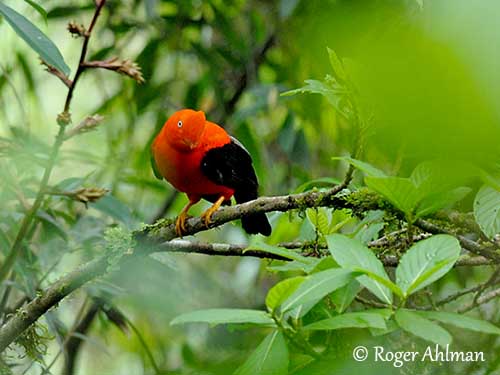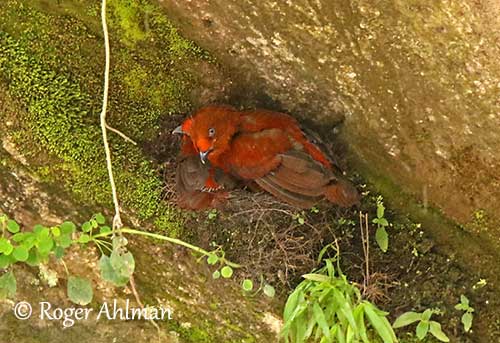
Andean Cock-of-the-rock
Rupicola peruvianus
Passeriforme Order – Cotingidae family
BIOMETRICS:
Length: 31-32 cm
Weight: M: 266 g – F: 213-226 g
DESCRIPTION:
The species here displayed is the subspecies Rupicola peruvianus sanguinolentus.
The Andean Cock-of-the-rock is the Peru’s National Bird.
The male of nominate race has bright orange head, body and most of lesser upperwing coverts. The rest of upperwing is black, except the grey tertials. The tail is black.
Underparts are bright orange.
On the head, we can see a distinctive crest made with two rows of feathers, forming a kind of semi-circular casque.
The strong, yellow bill has wide base. Both mandibles are laterally compressed towards the tip. The rictal bristles are lacking.
The eyes are pale orange. Legs and strong feet are yellow.
Fr: Coq-de-roche péruvien
All: Andenfelsenhahn
Esp: Gallito de las Rocas Peruano
Ital: Galletto di roccia delle Ande
Nd: Rode Rotshaan
Sd: Andinsk klippfågel
Photographers:
Roger Ahlman
Pbase Galleries Peru and Ecuador & My bird pictures on IBC
Didier Buysse
Vision d’Oiseaux
Text by Nicole Bouglouan
Sources:
HANDBOOK OF THE BIRDS OF THE WORLD Vol 9 - by Josep del Hoyo - Andrew Elliot - David Christie - Lynx Edicions - ISBN: 8487334695
BirdLife International (BirdLife International)
Wikipedia, the free encyclopaedia
VOICE: SOUNDS BY XENO-CANTO
The Andean Cock-of-the-rock male utters loud “yooii” at lek, but less raucous than the Guianan Cock-of-the-rock (Rupicola rupicola). We can also hear along, continuing clucking “kip-kip-kip”.
If disturbed, the birds of both sexes may give loud “uankk” while foraging.
This bird is usually silent outside the breeding season.
HABITAT:
The Andean Cock-of-the-rock frequents the montane forest and the thick humid woodlands between 1400 and 2400 metres of elevation on the eastern slopes of the Andes.
It is mainly found close to streams and in ravines with rocky cliffs.
FLIGHT:
The Andean Cock-of-the-rock has modified flight feathers with slender outer primaries which can produce some peculiar sounds during the flight and the displays.
DIET:
The Andean Cock-of-the-rock feeds mainly on fruits from several plant species. It plucks at the fruit while flying. It also takes large insects, and during the nesting period, the chicks are fed with small frogs and lizards.
RANGE:
We can find four subspecies:
R.p. sanguilonentus from W Andes of Colombia and NW Ecuador. This one has blood-red body plumage and deep red eyes.
R.p aequatorialis from Andes of W Venezuela, C and E Andes of Colombia, and E slope in Ecuador and Peru. This race is bright orange, with less grey on the upperwing and bright yellow or orange-yellow eyes.
R.p. peruvianus from C Peru.
R.p. saturatus from SE Peru and W Bolivia. It has deep orange-red plumage and pale blue to whitish eyes.
The females vary in eyes’ colour, from light red to whitish or brown.
The female is dark chestnut-brown with blacker throat and wings. She has smaller crest, pale whitish-blue eyes, blackish bill and grey legs and feet.
Immature resembles adult female, but the young male is more orange.


R.p aequatorialis
Female

R.p. saturatus
Immature
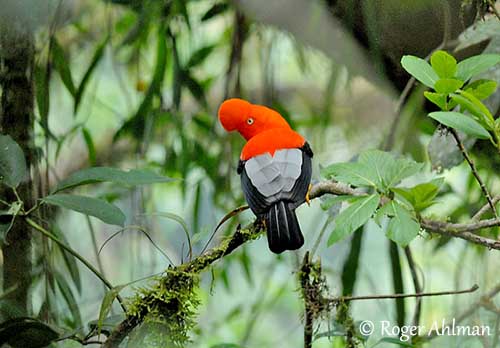
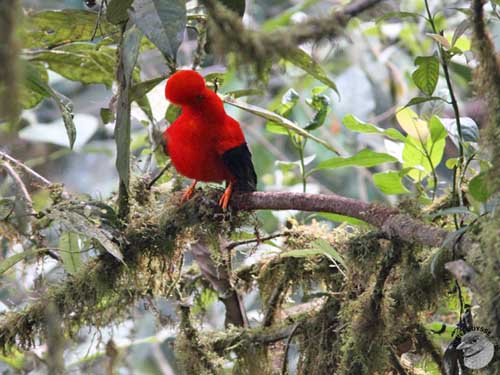

The Andean Cock-of-the-rock is polygamous. During the breeding season, the males display at communal leks where up to 15 birds may gather. Each male perches in tree at about 4-6 metres above the ground.
They perform ritual displays in pairs, such as bowing and head bobbing towards each other. They also jump, flap their wings and perform bill-snapping and calling.
These displays become intense if females approach. They usually perch in the nearby trees, looking at the displaying males. They cross the lek and choose a male. Then, copulation occurs.
The Andean Cock-of-the-rock is probably resident and may perform short-distance movements while foraging.
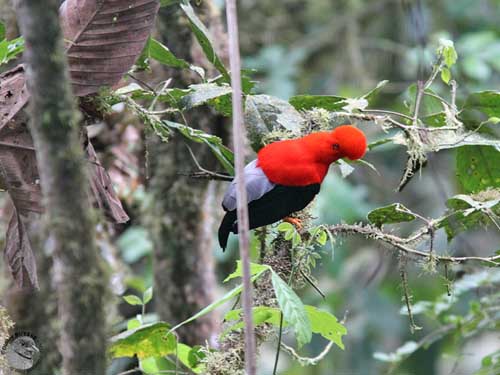
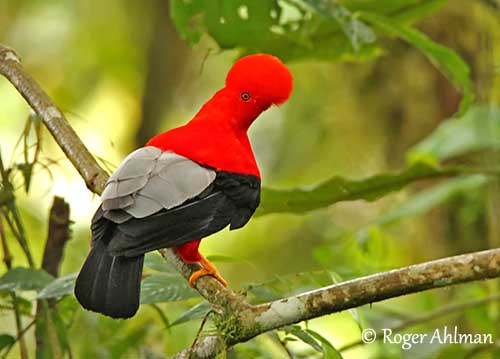
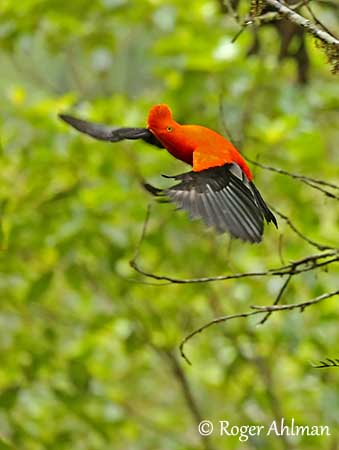
REPRODUCTION:
The breeding season occurs mainly in February-July in S Colombia, but this period may vary according to the range.
The nest is a cup mainly made with mud, usually in shape of truncated cone, attached to the rock at 3-12 metres above the ground. This cup is lined with coarse plant fibres.
Several nests may be relatively close to each other.

